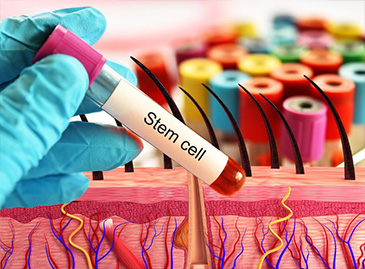
Fusion Biopsy for Prostate Cancer:Procedure, Advantages
The prostate gland is a significant part of a man's reproductive system. It helps with the production of the component of the semen. In this article, we will discuss the usage and accuracy of fusion biopsy to diagnose prostate cancer. A biopsy involves collecting or taking a sample with a biopsy needle from a suspected tissue with abnormal growth in the body.
Advancement in technology usage for investigating and diagnosing a health condition is the new order of the day—one of the significant advances in using modern technology such as guided fusion biopsy. The prostate cancer evaluation procedure has contributed positively to diagnosing prostate cancer.
A fusion biopsy procedure combines an MRI scan and ultrasound to give a clearer view of suspected abnormal cells in the prostate gland. In other words, it aids in the proper guiding of taking a sample from the alleged tissue with minimal side effects.
Advantages of fusion biopsy
The procedure uses one of the most advanced technologies to detect aggressive and non-aggressive cancerous cells in the prostate gland. However, using this procedure may mean less sample tissue will be needed for collection. The advantages include:
- It helps to reduce the diagnosis of insignificant cancerous cells.
- Bring about fewer false-negative results.
- It will help to reduce the number of unnecessary biopsies in the future
- The procedure will help reduce the chances of high-risk cancerous cell
- When you are an active surveillance patient, it will help promote calmness as you are confident of the effectiveness of this procedure.
However, experts suggest that fusion biopsy will help detect and accurately diagnose prostate cancer in its early stage.
Why does your doctor recommend a fusion biopsy?
Some factors may point to abnormal cell growth in your body. However, abnormal cell growth in the prostate tissue could mean the presence of cancerous or noncancerous cells. When your prostate-specific antigen (PSA) is on the high side or keeps rising, your doctor may suspect the presence of an abnormally grown cell. They may advise you to go for a fusion biopsy procedure. However, there is more than one reason why your PSA level may keep increasing, and prostate cancer is one of them. But do not panic until your doctor has conducted the necessary investigations and made a proper diagnosis.
Furthermore, reports indicate that over 700,000 men in America have an elevated PSA level. These men often undergo several biopsies to confirm the presence of cancerous cells. The usage of random sampling to detect cancerous cells may sometimes be inefficient. It can also miss some significant cancerous cells in your prostate. Instead, your doctor may decide to go for a fusion biopsy procedure to confirm the critical cancerous cells missed by random sampling.
Undergoing a fusion biopsy will help your doctor (urologist) determine the specific area requiring sampling. The procedure will aid the guidance of the biopsy needle to the exact suspected tissue. The process will help reduce the number of repeated biopsies. It will also help provide the atmosphere for an early-stage treatment option.
Who is a candidate for fusion biopsy
Before your doctor certifies you as the right candidate for this procedure, you must meet specific criteria. One criterion is a report of an elevated prostate-specific antigen (PSA) level. Elevated PSA can serve as an excellent pointer to suspect cancerous cells. Furthermore, if your doctor notices an abnormal lump in your prostate area during a digital rectal exam (DRE), a prostate biopsy may be required for further evaluation.
Lastly, there are several types of biopsies. Suppose you have done the traditional ultrasound-guided biopsies, and your doctor disagrees with the negative result. There may be a concern about the presence of the cancerous cell. You may be asked to undergo a fusion biopsy for prostate cancer.
Differences between traditional biopsy and fusion biopsy
Often, the traditional examinations may give an uncertain result. Some types of conventional biopsies include Transrectal ultrasound (TRUS). The significant setback of these biopsies is that they may miss some cancerous cells or give an inconclusive report. Hence, there may be a need for a fusion biopsy to help correct all of these setbacks—prostate cancer's specificity and detection rate increase when you undergo a fusion biopsy for possible cancerous cells.
Furthermore, traditional biopsies may not reveal all of the abnormalities in the prostate gland. Scientists indicate that the risk of infection is high as you may require multiple biopsies, which is not the case with a fusion biopsy procedure. Experts often refer to TRUS as a blind sampling method. During TRUS, your doctor may miss some actual cancerous cells.
Lastly, a fusion biopsy will reveal a clearer image of the abnormal cells in tissues. This will aid in adequately guiding the biopsy needle to the target tissue for sample collection.
Possible side effect
Like every other form of biopsy, fusion biopsy has its side effects. However, these effects are minimal when compared with a Transrectal ultrasound biopsy. However, the most familiar side effects are;
- Traces of blood in your urine during the recovery stage
- Minor or light bleeding from the rectum after the procedure
- Blood traces in the semen
- Minimized urinary tract infection
- Traces of blood in the stool
- Frequent urge to urinate
However, these common side effects can be challenging. But they only last for a few days. Your doctor will have informed you of these after-procedure effects. But if they persist for over two weeks, it is better to speak with your doctor for further clarification.
How does Fusion biopsy work?
The procedure is technology-driven. It usually involves a team of health professionals. Along with your urologist, a pathologist, a nurse, and a radiologist will join the health team. Since your doctor has certified you as the right candidate for this procedure, you might discuss the possible side effects to reduce panic. Your doctor will give you antibiotics and anaesthesia to numb you and make the process painless.
Furthermore, your radiologist will use a magnetic resonance imaging (MRI) machine to take a 3-dimensional prostate image. This will aid a clearer view of the prostate gland and the target tissues. The urologist will perform the biopsy with an ultrasound guide using the MRI scan as a reference. However, the MRI images will be fused with real-time images from the ultrasound during the fusion biopsy procedure.
Combining these two images will increase accuracy and help your urologist separate the healthy cells from the abnormal ones. Your doctor will carefully guide the biopsy needle into the target tissue to collect the sample. Since the images will be fused, your urologist can collect an accurate and precise sample. The sample collected will be given to a pathologist for viewing under the microscope.
Possible results after the procedure
Once the fusion biopsy is successful, your pathologist will take over the next step. The pathologist will place the sample under the microscope for viewing to conclude. Here, a description of the sample retrieved will be done. A description of the tissue's colour and consistency might serve as the first clue. If the tissue is abnormal, your pathologist will note this. The pathologist will grade the development stage if the cells become cancerous.
There is a possibility of aggressive and non-aggressive cancerous cells. The pathologist will conclude before your urologist gives a final diagnosis.
Is this procedure painful?
Biopsies involve using needles and devices. The procedure may make you slightly uncomfortable. But, the pain is usually reduced compared to other types of biopsies. Before commencing the process, your doctor will administer an anaesthetic injection. You might not feel any pain during the procedure due to the anaesthesia. But, you may feel a slight discomfort with the injection. As the biopsy needle finds its way into the targeted tissues, you may feel uncomfortable. Generally, this procedure will be painless when your urologist numbs you with IV injections.
The time frame for the recovery phase
Since this technological procedure gives a close-to-perfect result, further biopsy may be unnecessary. This may mean your recovery phase after this procedure will be fast. However, it may take up to a month to recover completely. If you notice any change in body function, contact your doctor for immediate intervention.
Questions to ask your doctor
You might ask your doctor the following questions if you require more information before agreeing to proceed. A few of the questions include;
- What are the possibilities that the procedure will lead to a cancer diagnosis?
- What can I do to prevent or minimize the effects of complications after undergoing the procedure?
- If you are using blood-thinning medications such as aspirin, ask if you should stop it.
- What is the cost implication of fusion biopsy?
How long does the procedure take?
Generally, the procedure may take about 45 minutes to 1 hour, depending on the satisfaction of your urologist.
Is fusion biopsy better?
Researchers indicate that targeted fusion biopsies are better and more precise than the traditional TRUS biopsies.
Cardiology Price Turkey



